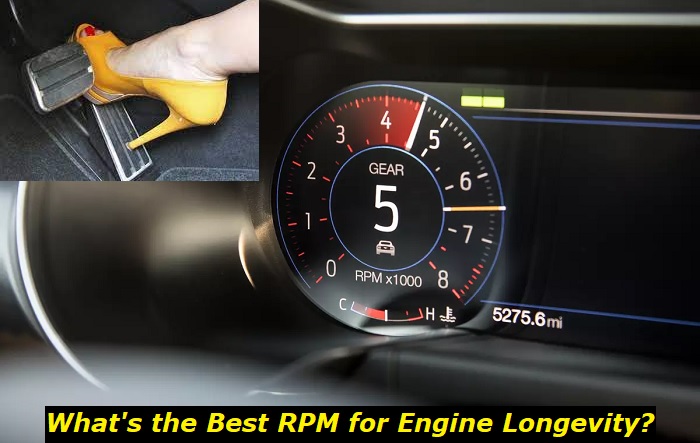When it comes to the best RPM for driving, there are extremely different beliefs and opinions. While one group of drivers is sure that you should always drive at low RPM to save fuel, the other group is confident that only at higher RPM the engine will be lubricated properly. And while automatic transmission made these arguments quieter, it's still a serious question to discuss.
In short, the best RPM level for your engine longevity depends on the load. But there are some rules that you should know. The RPM should never be too low because it can cause problems with the lubrication. But too high RPM will also hurt some tender elements of the machine. So, you will need to learn some science behind engine work.

Here's what I will be discussing today:
- RPM and longevity - is there at all any connection?
- Driving at low RPM - why can this be a bad rule?
- Driving at too high RPM - any serious problems?
- Choosing RPM in accordance with the load and road conditions.
- Some tips to balance longevity and economy questions.
Let's get started!
Are common engine RPM and longevity connected?
It's a long-lasting belief that the average RPM of your engine is connected directly to the longevity of the machine. Well, it is true. But only if you drive your engine in extreme conditions. If you just drive like an average driver, you will possibly not even feel the difference in longevity and your engine will most likely live an average life.
But still, as a curious car owner, you may want to know why the RPM in your engine actually has something to do with its durability.
Here are some obvious reasons for that:
- when your engine runs at low RPM other than idling, it gets loaded but doesn't get lubricated because the oil pump has a low speed of rotation;
- if the RPM is low, the engine doesn't produce the proper power and torque and is still made to pull your car at a certain speed;
- the weaker the engine, the higher RPM it needs to stay healthy, because otherwise, the load on it may be super destroying;
- at too high RPM, the engine starts heating up and the cooling system doesn't have the possibility to cool it down a bit;
- also, at high RPM the oil overheats and becomes too thin leading to poor lubrication when it's badly needed;
- overheating at high RPM leads to a change of volume in some parts of the engine and they may start rubbing on each other.
This just means that both too low or too high RPM are not that good for your engine. If you love extreme driving or try to always drive at the lowest possible RPM for the desired fuel economy, you should rethink your driving strategies. This will obviously help you seriously prolong the life of your engine in comparison with what you are going to get with your habits.
It's important to adjust your engine revolutions to every road situation. Being flexible is the key to success in terms of both safety and longevity. But let's look at the nature of low-RPM and high-RPM driving.
Driving at low RPM - what problems can you get?
When you drive at too low RPM, the immediate consumption monitor shows wonderful figures. You may get 30 MPG from a car that normally would offer 24 MPG. But there are some tricks.
First of all, this is not possible in the long run. Once you lose the inertia power, the fuel consumption will become worse because the engine obviously suffers and will burn more fuel. Secondly, the load on the engine is becoming heavier.
Have you ever ridden a bicycle? The principles are just the same. When you go uphill, you try to change the gears in such a way that you rotate the pedals faster but the wheels would rotate slower. This makes it easier for you to get up the hill.
The same works with car engines. They need higher RPMs whenever the load is higher. This is just easier for them to work and maintain proper condition of coolant, oil, and other important parts and components of the engine.
Driving at high RPM - why is this not good?
While engines would obviously feel better at high RPM, they don't like working for a long time at super-high revolutions. The problem is with the overheating. When the engine heats up too much, its head starts suffering. The gaps between parts are so tiny that even a small change in the shape and volume of metal parts may lead to catastrophic damage.
Interestingly, driving at high RPM also has an effect on oil. The oil gets thinner and doesn't lubricate the engine the way it should. It means that the longevity of the engine is affected. When its parts are not lubricated properly, it's impossible to expect that such an engine will last really long.
Of course, it also depends on what you consider high RPM. For a modern engine everything that is higher than 4000 RPM is considered high. Also, it's not recommended to drive for a long time at anything higher than 3000 RPM.
The limit of what to call "high RPM" depends also on the displacement of the engine. Larger non-turbo engines hate going at high RPM. While it's not that bad with smaller turbocharged engines you just need to rotate badly to get at least some power.
Choosing RPM according to the engine load
Modern engines usually have pretty serious power and torque. You can drive them even if the load is extremely high. Of course, modern automatic transmissions make it much easier for a driver to choose the proper gear and drive with proper RPMs. But still, even with the automatic transmission, you can control the level of RPM that you use for driving.
Here are some things you should consider:
- when you drive on the highway with a constant speed, your RPM should be between 2000 and 3500 revolutions depending on your speed and the type of your engine;
- when you are towing, the RPM will usually be higher than usual and it's recommended to go on lower gears than usual;
- to save the engine from damage, it's better to go at a higher revolutions when going uphill or experiencing any other extra load;
- in terms of speed, if you go on the highest gear, you will accelerate only thanks to higher RPM, so find a reasonable balance to avoid damaging the engine;
- during your usual city driving, try keeping the RPM between 1500 and 2000 revolutions.
This is just a simple set of recommendations that you should use in your everyday driving. The problem is that automatic transmissions don't allow us to control RPM, especially when we drive in the city. But if you see that you constantly drive at 1200 RPM or 3000 RPM when cruising through the city, you should make sure that everything works fine.
You may also try manual modes to shift gears or you may change the mode from D to S to see if this helps. Anyway, you should avoid extremes when driving on your usual routes. Because this will not add any longevity to your engine.
Finding the proper balance between economy and longevity
I've heard a lot of times good car mechanics saying to clients (and to me also) that the driver should decide what they want to achieve - fuel economy or engine longevity. But this is ridiculous because both come together.
Actually, the best way to find the most appropriate driving mode for your engine is to look at the fuel consumption monitor. The moment when your engine takes less fuel and gives optimal speed is the best moment for the engine. Why? Because it doesn't experience loads at this moment!
When your engine starts burning fuel like crazy, it means that it gets too much load. For example, the RPM is too low for the weight of the trailer and the engine burns more fuel to produce more power and torque. Or you go at 100 mph and the engine burns way too much fuel to just keep up with your desired speed.
Both situations are bad for both fuel economy and longevity.
So, it's almost always possible to define the best driving mode and RPM for your car just by looking at fuel consumption. In most cases, this is going to give you important tips on how you should drive.
Final thoughts
Although I usually don't care much about the potential longevity of my engines (because I drive cars for 2-3 months and change them due to my job), it's always been interesting to me how one can prolong the life of the engine.
And I should tell you that with years of experience, I came up with one conclusion: you should concentrate on oil and filter changes, good fuel, and proper reaction to any problems. Don't ignore issues, even the minor ones, and also buy proper filters and parts for repair.
The question of RPM is pretty naturally solved by modern automatic transmissions. But, in this article, I did my best to open this topic for you.
About the authors
The CarAraC research team is composed of seasoned auto mechanics and automotive industry professionals, including individuals with advanced degrees and certifications in their field. Our team members boast prestigious credentials, reflecting their extensive knowledge and skills. These qualifications include: IMI: Institute of the Motor Industry, ASE-Certified Master Automobile Technicians; Coventry University, Graduate of MA in Automotive Journalism; Politecnico di Torino, Italy, MS Automotive Engineering; Ss. Cyril and Methodius University in Skopje, Mechanical University in Skopje; TOC Automotive College; DHA Suffa University, Department of Mechanical Engineering






Add comment